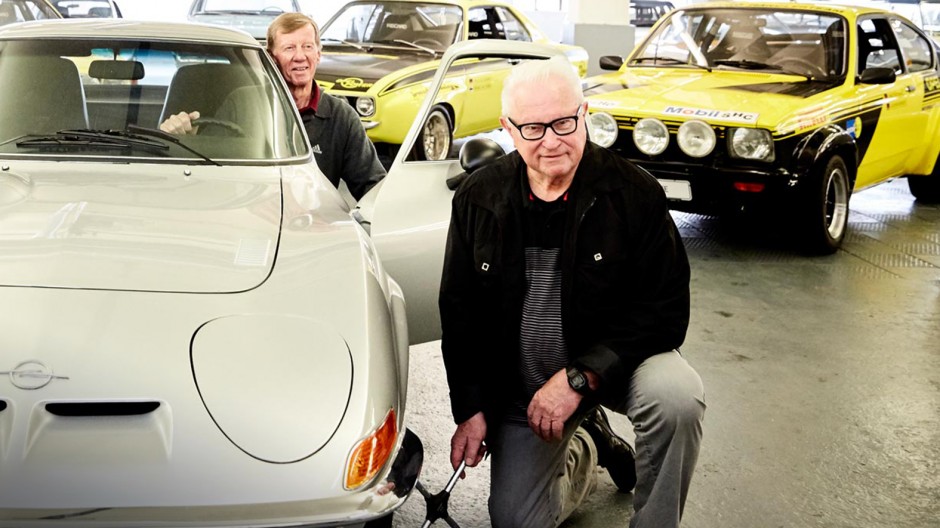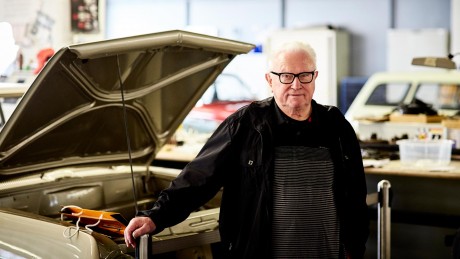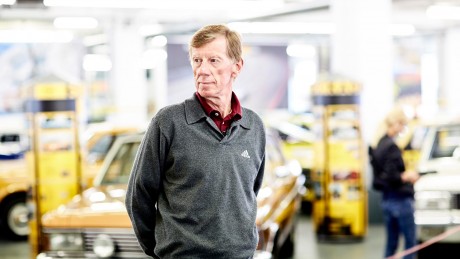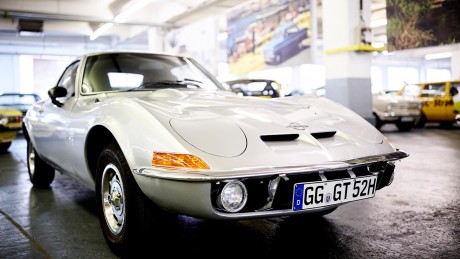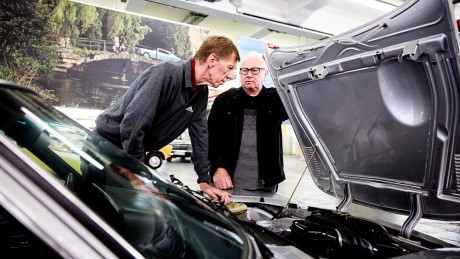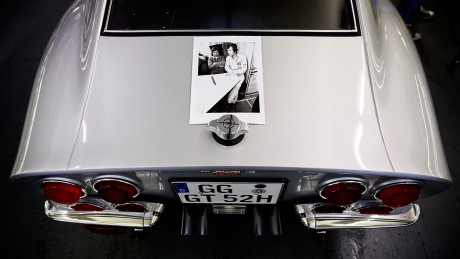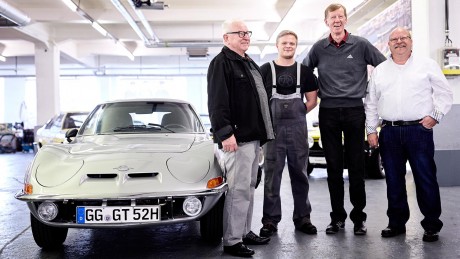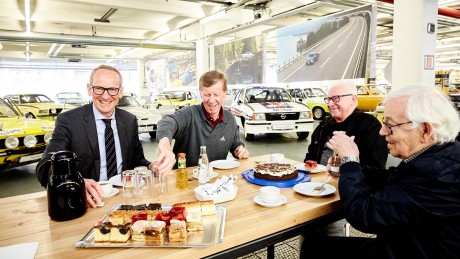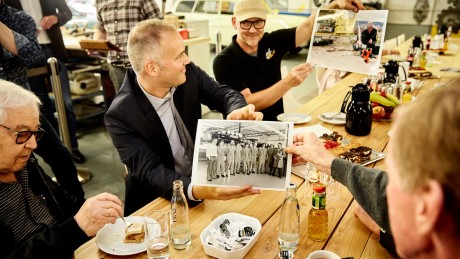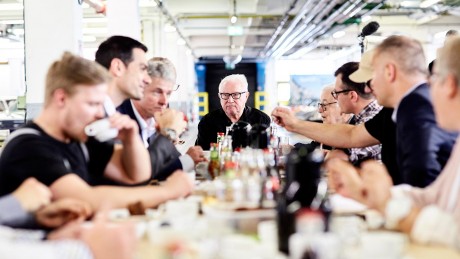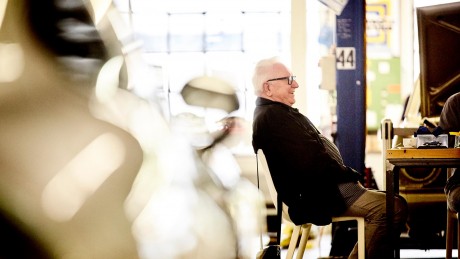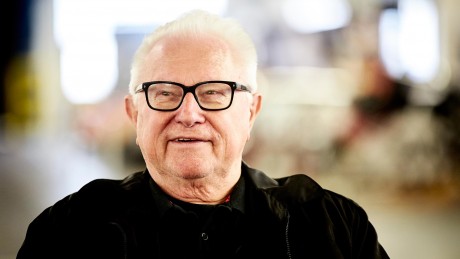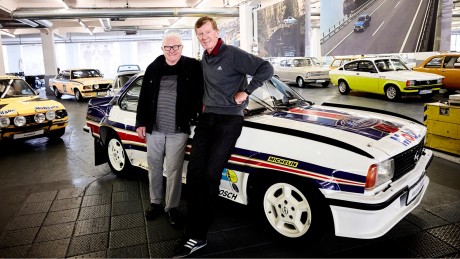- He knows how to get Opel running hard and fast: Herbert Fabian helped along the brand’s presence in the motor sports arena for 25 years. Now, in the Opel Classic workshop, he meets his former companion and friend…
- … Walter Röhrl once again – and for a special occasion. The former rally world champion bought Fabian’s favorite car, a silver 1973 GT. Fabian had been restoring the Coupé for years, and the separation wasn’t easy for him.
- “The GT deal came about after I had invited Walter to my birthday in Trebur last October,” reports Fabian. The former mechanic confessed to the rally legend during a conversation that climbing into his greatest Opel treasure had since become difficult for him. “When I said that I wanted to sell the GT, Walter interjected immediately: ‘The buyer’s right in front of you.’”
- For Röhrl, a long-cherished dream comes true. “There are three reasons why I wanted to have the GT. The first is that, in my youth, everyone, even me, dreamed about this Coupé. And now I’m fulfilling my long-time dream.” Furthermore, it’s that “the car reminds me of my time and joint successes with Opel, but also of my friendship with Herbert Fabian.”
- Then rally racing fiends, now classic friends: The photo from the 1970s, placed by the photographer on the rear of the GT, shows Fabian (left) and Röhrl during a race break.
- Working through the family: The vehicle changes hands in the Opel Classic shop, a symbol of how deeply connected Herbert Fabian is to the company. His son Thomas (50), with Opel since 1981, works in the powertrain, and grandson Lars (19), who completed his training as an automotive mechatronics engineer, greet Walter Röhrl. Incidentally, Herbert Fabian’s father Wilhelm also built cars in Rüsselsheim in the 1920s.
- The automotive quartet: Even Dr. Karl Thomas Neumann, GM Executive Vice President & President Europe, (left) and GT designer Erhard Schnell weren’t going to miss out on the event. When Röhrl is offered some water over coffee and cake, the rally icon answers the question “With or without fizz?” with a dry, “Nothing works for me without gas.”
- Living history: Harald Hamprecht, General Director Internal & Corporate Communications (second from left), joins Jens Cooper of the Opel Classic workshop in contemplating photos from the time when Herbert Fabian and Walter Röhrl shaped motor sports for the brand with the lightning bolt.
- Southern Hessian with a North German dialect: Fabian was born in the town of Wiebelsbach in the Odenwald mountains in 1934, but grew up in Papenburg (Emsland), where he completed his training as an automotive mechanic. In the 1960s, he moved back to Hesse with his wife.
- On his success with Röhrl: “Back then Walter was at the height of his driving skills, and I just did my job as usual.”
- “The years leading up to seizing the world championship in 1982 were intense,” says Fabian. “Hard work, losses, doubt, but likewise many conversations, mutual trust, and fun, everything that binds people together.”
- The mechanic and his world champion driver: Fabian and Röhrl pose together in front of an Ascona 400, the car with which they and their team brought home the title.
Walter Röhrl really builds up momentum by the time he gets to the “craziness of the West African bush” when he talks about his former Opel head mechanic. October 1982: the Rallye Côte d’Ivoire is the second to last world championship race, and it’s still rather early in the race. Röhrl (Ascona 400) and his opponent Michèle Mouton (Audi Quattro) have begun a fierce duel for victory on the track and in the standings. “Then I broke my rear axle in the middle of the wilderness,” reports Röhrl.
RÖHRL IS OUT, FABIAN NEEDS TO STEP UP TO THE PLATE
A disaster beyond expectations. Reporters mob him from the media train and ask how it feels to have just lost the World Championship title. “I remember I tried to seem cool on the outside, but I was actually a total wreck.” Röhrl’s only hope was “that Herbert would come soon and straighten out the matter.”
His prayers were answered when Herbert himself appeared, and the rest is history: Under the most adverse conditions, the service team of Herbert Fabian was successful in fitting the Ascona 400 with a new rear axle. Röhrl and co-driver Christian Geistdörfer still won the race, and then the world championship, for Opel.
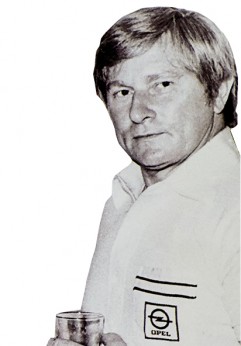
1971, Herbert Fabian, Opel head mechanic for motorsports.
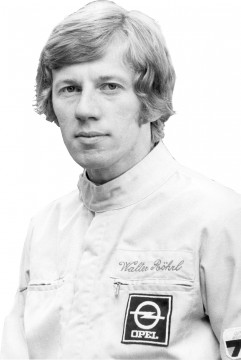
1973, Opel driver Walter Röhrl.
“Herbert was No. 1. Nothing, not even the trickiest of technical breakdowns, could ruffle him,” said Röhrl. “He was the problem solver everyone else relied on. And that’s exactly what you need if you want to compete among the best.”
MISTER UNDERSTATEMENT
Herbert Fabian (81) brushes off this compliment with a wave of the hand. “Back then Walter was at the height of his driving skills, and I just did my job as usual.” Quite an understatement for someone who, up until his retirement in 1992, kept motor sports running at Opel for a quarter of a century.

1982, the Rally World Championship is decided on the Ivory Coast: Walter Röhrl and his co-driver Christian Geistdörfer in the Ascona B are heading out fast after Herbert Fabian’s repair work.
Videocast @KT_Neumann #36
www.youtube.com/watch?v=LgubNceWs64
↑ Opel CEO Dr. Karl-Thomas Neumann meets a real Opel motorsports legend: Walter Röhrl, the Rallye World Champion from 1982. Find out, why the Opel GT won over Walter Röhrls heart and get some insights on the Ascona A, the undefeatable car that Walter Röhrl won the European Rallye Championship with in 1974.
Fabian joined the company in 1963, first as a test driver and then as a mechanic. Shortly afterward he fully immersed himself in the world of Opel racecars. In 1967 he looked after the driving duo of Hans Beck and Herbert Heuser, who started in a Kadett B 1.1 at the Rally dei Fiori. Fabian’s responsibility: fueling up, changing tires, and rapid diagnoses and repairs when something jammed or crashed.
SLEEPLESS IN ITALY
Time off was frequently restricted to little naps on the side of the road or in the paddock. That’s because Fabian worked well into the night, servicing the engine and changing the shock absorbers, cables, and hoses, “and then I played cleaning lady until the car shone.”
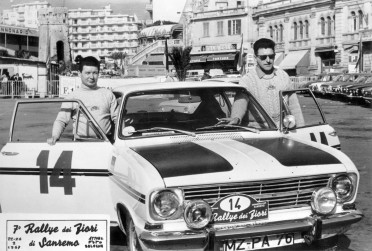
1967, Rally dei Fiori, Italy: Hans Beck and Herbert Heuser (left to right), both employees of the Opel test department, triumph in a Kadett B Coupé.
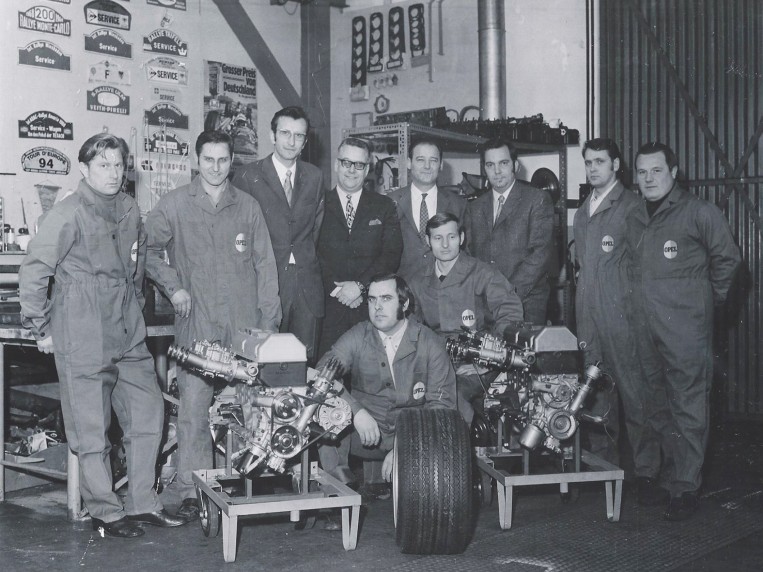
Early 1970s, Rüsselsheim: Mechanics and designers from Opel’s vehicle and engine development assemble around two liter transverse engines. Herbert Fabian is on the left.
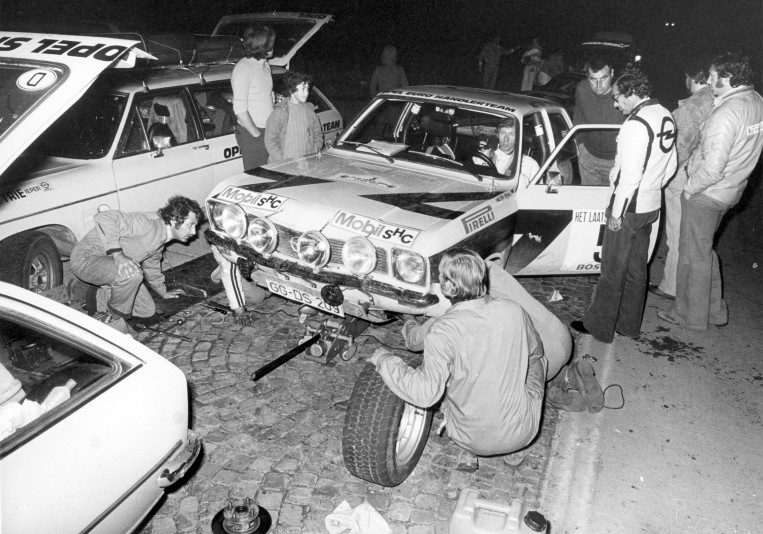
1974, Rallye d’Ypres, Belgium: The front axle causes problems. One of the few defects the Ascona A suffers this year. The service team working with Herbert Fabian (in foreground with tire) is on the scene.
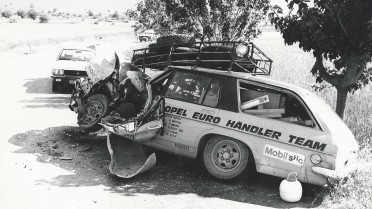
1975, Acropolis Rally, Greece: That was close – what Fabian’s car looked like after the accident.
And so it went from then on. Herbert Fabian spent half of the year on tour with Opel, for years upon years. He enjoyed the circus and its adventures. Like at the Rallye Tour d’Europe, a total of 15,000 kilometers in twelve days, over the Balkans, Kuwait, North Africa, Western Europe, and finally to Travemünde, the destination. Danger was part of everyday life – like at the Acropolis Rally in the mid-1970s, when Fabian’s service car collided with a cement truck. He threw himself from the driver to the passenger side at the last second, saving his life.
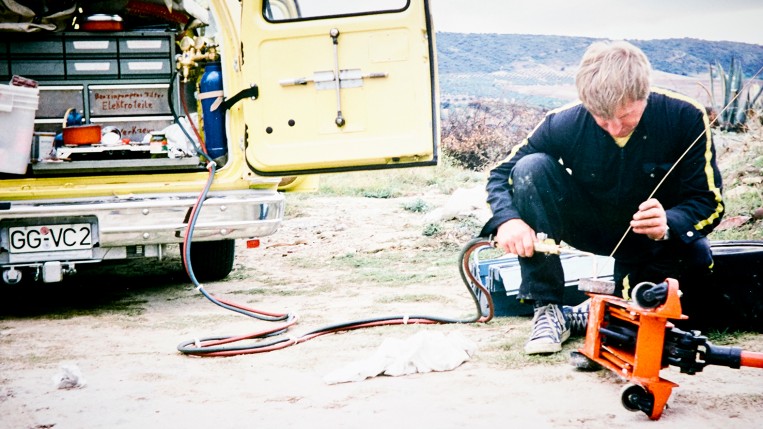
Even the jack has to be fixed: Fabian, sporting Chucks and a tracksuit, tending to his equipment during a rally.
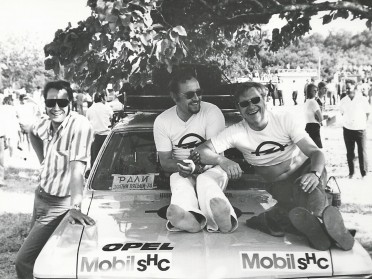
Early nineteen seventies, Opel motor sports veterans: Herbert Fabian (right), Jochen Berger (middle), and Friedel Meuer.
Opel motor sport workers even fine-tuned their comic skills under Fabian. During inspection of some rally cabling he blew the smoke from his cigarette, unnoticed, into an air nozzle in the dashboard. “No electrician has ever shot out of an Opel that fast to disconnect the battery, before or since.”
OPEL WORKERS AT HEART AND IN EVERYDAY LIFE
All of this was possible because Herbert Fabian’s family is proud of him and lets him do what he wants. “We’re all Opel workers, at heart and in everyday life,” he says. His father, Wilhelm, even worked in Rüsselsheim back in 1924. Currently, his son Thomas (powertrain) and grandson Lars (automotive mechatronics engineer) are also part of the company.
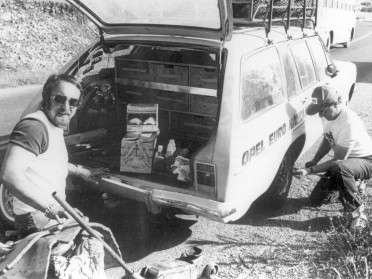
1974, Bernhard Zech and Herbert Fabian (left to right) working on their service car, an Admiral with the rear of a Rekord D caravan.
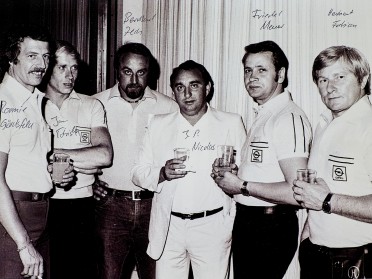
The Opel team working for rally driver Jeanne-Pierre Nicolas (middle), Herbert Fabian standing on the right. The photo with handwritten names comes from the private archive of Opel Classic colleague Jens Cooper.

After the victory at the 1974 European Rally Championship. The Opel team with Walter Röhrl, Jochen Berger (second from right), and Herbert Fabian (third from right) standing next to the Ascona A.

1982, Monte Carlo: Walter Röhrl and Christian Geistdörfer win the Monte Carlo Rally for the second time in a Rothmans Ascona B 400, and also become world champions.
Fabian considers his “most exciting and most successful phase” to be his collaboration with Walter Röhrl. The Southern Hessian began supporting the Upper Palatinate in his journey to the world champion title on the Ascona A in 1974. “The years leading up to seizing the world championship in 1982 were intense,” says Fabian. “Hard work, losses, doubt, but likewise many conversations, mutual trust, and fun, everything that binds people together.” The two are still friends today. When Röhrl recently acquired a GT restored by Fabian, they relocated the event to the Opel Classic shop.
THIS TIME HE DOESN’T BRUSH IT OFF
There, the past rally master says, “Opel is once again capable of building competitive vehicles, for the road and off-road. And with employees who exemplify the spirit of the brand, the glory days will return.” This time, his head mechanic doesn’t brush off the praise. Herbert Fabian smiles and nods.
Last update June 2016
